What is Salsa Guitar?
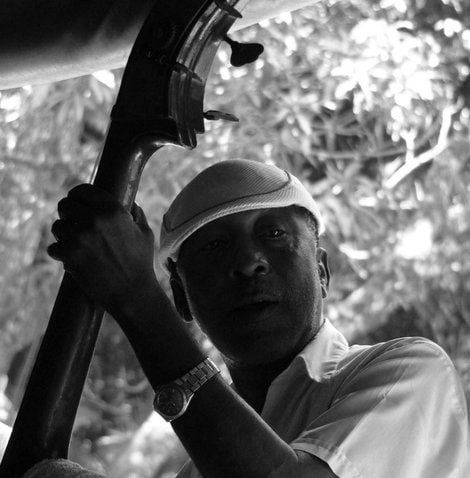
You can call it salsa guitar or playing montunos or trying to sound like a tres.
Salsa guitar seeks to lock into the clave-driven groove.
In my humble opinion
In salsa music (or really anything ‘salsa’ related/inspired), the versatility of the guitar means it can fill many different musical parts/roles, for example:
- The tres/cuatro montuno vibe – a lot of what (imho) people think of as “salsa guitar” is pretty much the guitar covering the tres/cuatro part – it can sound really good on guitar, too!
- As a soloist – like Carlos and his brother Jorge Santana
- Piano – Much like playing the tres/cuatro part, but can have different feels, etc
- Horns line and hits – horn hits can sound really cool on guitar
- Voice/Melody – a great way to better learn the song, and sometimes the singer may need to take break, so it may come in handy!
- Bell pattern/cascara – very uncommon but possible with muted string and/or percussive effects on an acoustic guitar or muted strings on an electric
- Conga beat – also very uncommon but with muted string and/or percussive effects on an acoustic guitar it can sound cool. Great for really small groups and/or solo gigs where’s there not really a dedicated percussion player and everyone is trying to pickup a little bit of what a percussionist would play
What is Salsa Music?
Plenty of styles of latin music more or less fall under the “salsa” umbrella (depending on who you talk to):
Mambo, son, son-montuno, montuno, cha-cha, songo, timba, latin jazz are some that are fairly well known styles. (At least enough so that I know about them).
This article is a lot of what I’ve personally learned about how to play salsa guitar – I am still very much a student of clave-driven music, and am still seeking to learn more, but please check out some of these cool ideas I’ve picked up along the way.
Table of Contents
Best Wishes and hope this helps!
“Salsa guitar” is cool because it helps you look at how the guitar can be played in a different way, especially if you are used to playing more strumming chordal styles.
It also helps you focus on your time and groove. Plus you get to play salsa!
Learning Salsa Guitar – Starting Out
One way to start playing salsa on the guitar is try to play what either a tres or cuatro is playing – or try an imitate the essence of what the piano is playing.
The basic riff (called a montuno) would be something like what you hear on La Bamba, but unless you are playing La Bamba, you don’t want the montuno to sound like La Bamba!
We’ll get back to playing a few montunos (and the tres and cuatro) in a bit.
First, let’s check out some basic salsa rhythms so you can play a montuno in the groove.
Once you hear the different parts (of the salsa groove), it’ll be easier to play with the rest of the band.

Questions? Ideas?! Lessons & Coaching!
Questions, ideas, comments about learning salsa guitar? Or another aspect of guitar playing? I am still learning a lotmyself, but would love to help you on your musical journey!
Please leave a comment and/or send a message! I try to respond as soon as I see the message and have time to answer.
Also, if you’re interested in personal coaching and lessons, please check out:
Learning about the Clave, the Tumbao, the Cascara, the Bell and Güiro.
Before or simultaneous to learning a few starter riffs to play on guitar (depending on who you talk to, called montunos or tumbaos…), definitely check out these different interlocking rhythms that really make salsa music what it is.
These interlocking rhythmic patterns (montunos, clave, tumbao, etc) weave together to create an amazing, magical groove that gets people wanting to dance.
If you learn the different rhythms you can hear better where you fit in, plus understand the accents, and also get a better feel for everything. Moreover, you’ll be able to apply this rhythmic framework to many different styles of music, from 2nd line to funk to reggae to baroque music.
Clave
Clave or “the key”, is the rhythmic framework that the rest of the beats relate to. (You can practice with the clave by getting my clave project for beatcraft)
For the moment, learn the 2-3 son clave. It goes like this:
The count is one TWO THREE four ONE two AND three FOUR.
We will come back to the clave. For now, just tap the beat with your foot and the clave with your hand. It sounds something like Ba ba baa baa ba. More or less!!
Once you start feeling the clave, the music will “groove” harder.
If you want to learn more about the roots of the son clave, please check out this page about the Short Bell, Long Bell, and Universal Break, where you’ll learn about the 6/8 short and long bell, the 4/4 rumba clave and the 6/8 clave, as well as how the 4/4 clave relates to the 6/8 clave. Note: they count the 4/4 rhythms in half-time, whereas this lesson counts with eighth notes, not sixteenth notes. So here we’d count 1,2,3,4,5,6,7,8. There they would count 1+,2+,3+,4+.
Tumbao
Tumbao can have different meanings but here we are talking about the bass part that was adapted from the tumbao drum part in more traditional styles of Afro-Cuban music.
Whatever the bass player is playing would be considered the tumbao but the “classic” tumbao bass line rhythm that most people think of is to play on 2+ and 4 or every measure, plus sometimes mentioning the 1 on the 2 side of the clave.
The orange highlights signify the tumbao in the diagram below.

How to Play a Tumbao and Montuno on Guitar
Please check out Playing Tumbao and Montunos Together, Fingerstyle Salsa Guitar Studies/Lessons to learn more about playing the bass and the montuno riff at the same time!
Please note, that while I have some experience with playing salsa music, I am certainly by far not an expert! So please check out the lesson, but please also continue you search for other sources of knowledge!
Cascara/Campana/Bell Patterns
Cascara means shell and the patterns are usually played on the shell of the timbales. You could also play them with a bell. There are few different patterns that are traditionally played with the bell. They relate to the clave. The purple x’s in the diagram below are the cascara pattern.

You can read an in depth discussion on bell patterns at Wikipedia.
It starts with bell patterns in 6/8 but eventually gets to the bell patterns in 4 in Cuban music.
Remember that they are counting 1,2,3,4 whereas we are counting 1,2,3,4,5,6,7,8. In other words in cut time versus 4/4.
Note: they count the 4/4 rhythms in half-time, whereas this lesson counts with eighth notes, not sixteenth notes. So here we’d count 1,2,3,4,5,6,7,8. There they would count 1+,2+,3+,4+.
Combining Clave, Tumbao and Bell Patterns
All the cool interlocking rhythmic patterns give salsa-style music such beautiful groove!
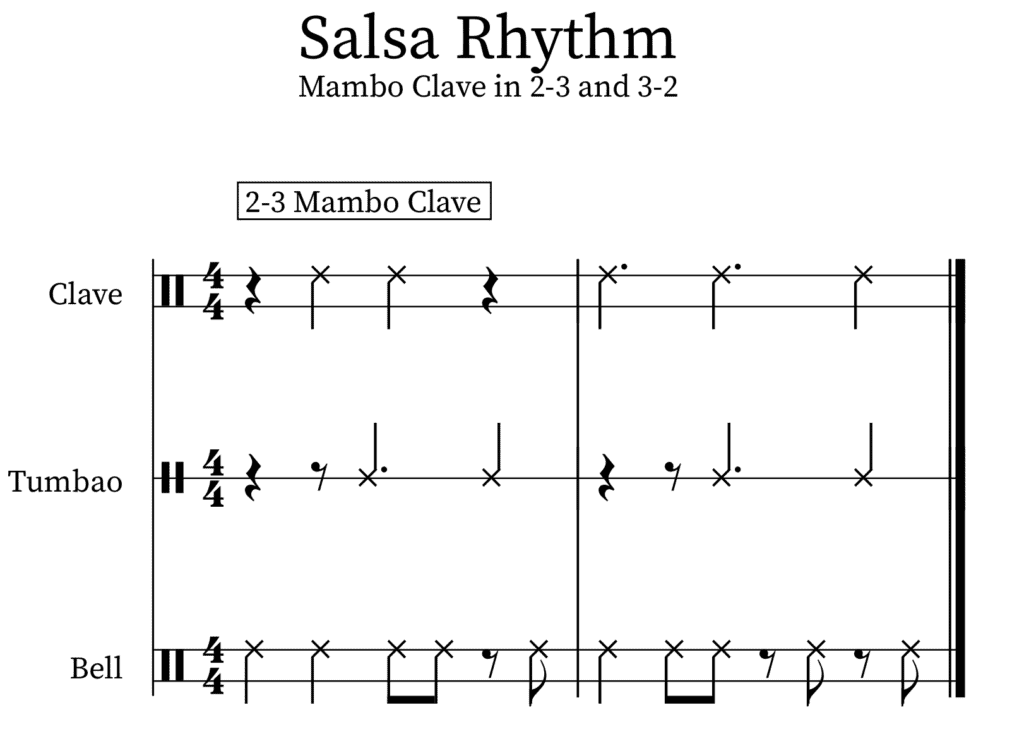
Here’s a video where you can see the cascara and the son clave being played together.

Improve Your (Right-Hand) Salsa Guitar Groove!
Here’s some cool right-hand, muted exercises that are a great way to start get the feel for some of the basic rhythmic elements of salsa/mambo music.
These exercises are a great intro to clave-driven music.
Plus, you’ll hear how it connects to funk guitar, and (if you swing it) to New Orleans Second Line and funk!
Practice them with muted strings, both strumming and on a single string.
Practice slow (and relaxed) to learn fast!
The Tresillo
In addition to the tumbao, clave, and bell patterns discussed above, please also check out the tresillo. It’s a great way to feel the tumbao, and is another fundamental pulse to clave-driven music.

Clave-Driven Groove Study



We’ll get to the montunos soon!
Please check out some other lessons on improving time and groove!
- Improve Solos – Right Hand Groove (Jazz Guitar version)
- Better Groove – Six Fun Practice Ideas!
- Jazz Guitar Ideas – Count Out Loud – Improve Time and Groove !
- Better Time – 10 Ideas for Musicians
- Make your Own Backing Track (5 Minute Practice Ideas)
Learning to Dance Salsa
Half the fun and beauty of salsa is the dance. And, dancing helps your time!
I’m pretty sure most musicians in the salsa community can dance. Look at Los Van Van and Fania All-Stars!
You can count dancing as practice time, too! Pick a slower song (or a cha-cha-cha and just dance the mambo slowed down to practice) and just groove on the basic step.
You can sing and play the different parts like the clave, the cascara, and the tumbao if you want more of a challenge. Don’t give up too soon. And don’t give up on the basic mambo too soon either.
Like the needle said to the record : it’s all about the groove. And remember to make sure your feet are hitting the floor in time to the music.
This song includes a tres playing the main montuno.
Montuno Patterns for Salsa Guitar
Practice Slow to Learn Fast!
Focus on good time and playing relaxed – the speed will come all in good time!
Video Lesson for some of the Montunos
One Chord Montuno
So we will start with a montuno in just A minor. You can pick any note from the chord but play with the following rhythm.
So follow the rhythm of the tao sign in green. The count is 1, 2 2+, 3+, 4+, 1+, 2+, 3+, 4 4+. The numbers above are the two bar count. The red numbers are the clave (2/3 mambo).
The rhythm is more important than the actual notes. Simple montunos are 2 bar phrases.
Some Examples of A minor Montunos (Treble Clef, Clave, Tab, PDFs)
Here’s some ideas to get you started. Please remember to try variations and different patterns. These are just ideas. Of course, learning from the music will always help a lot, too!
PDF of some sample A minor montunos. Also, please view Salsa Guitar Montuno Examples (with Tab, Clave, Treble Clef – PDF).
Playing 2 Chords (Common Salsa Harmony)
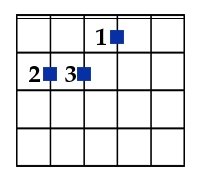

With a 2-3 clave play E major and then change to A minor on the 4+.
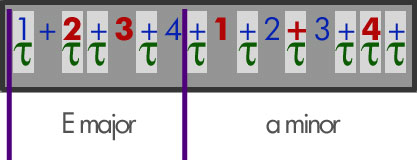
Some Examples E to A minor Montunos (Treble Clef, Clave, Tab, PDF)

Check out the PDF, Salsa Guitar Montuno Examples (with Tab, Clave, Treble Clef – PDF).
Video of E7 to A minor
Here’s a video where I play E major to a minor:
Playing 4 chords
Here’s a general overview of one way to approach playing 4 chords in a montuno style. Focus on good time & groove.

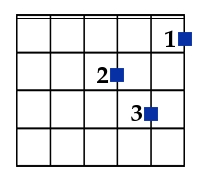


If you are playing in a 2-3 clave, you play the A minor chord on the 1, the D minor on the 2+, the E major on the 4+, and the D minor again on the 2+ of the second bar.
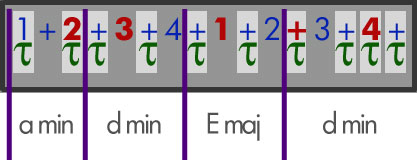
- Start out playing the just chords
- A minor on 1, D minor on the ‘& of 2’, E major on the ‘& of 4’, D minor on the ‘& of 2’
- Then play the arpeggios of the chords but switch on the same beats, the 1, the 2+, the 4+ and the 2+. It may sound complicated but it is pretty straight forward once you start feeling the groove.
Some Examples of A minor, D minor, E, D minor Montunos (Treble Clef, Clave, Tab)
Check out the PDF, Salsa Guitar Montuno Examples (with Tab, Clave, Treble Clef – PDF).
Video of A minor, D minor, E major, D minor montuno-type guitar
Here’s a short video where I play a little with these four chords:
Use the Same Rhythms but with Different Chords

- To start – Play the same montuno rhythms used in the previous examples (see above)
- Replace the chords in the examples with the chords you want to use.
Get some recordings to play along with or a beat with clave and experiment playing some of the rhythmic patterns used in the examples shown on this page.
Do the same thing for major chords
Now do the same thing with a major I-IV-V-IV. Let’s do A major. So A-D-E-D. All major chords. Get the timing. Then arpeggiate.
Some Montuno Ideas for One Chord
You can transpose this to any key – I plan to add 3-2 clave and more info soon …


Lots more possibilities
As you can hear there is so much more you can do. But being able to play a major groove and a minor groove are good places to start out.
Check out How to Play a Montuno and Tumbao Together on Guitar!
Here’s more examples of montunos (with and without the tumbao).
Playing Tumbao and Montunos Together, Fingerstyle Salsa Guitar Studies/Lessons
Play along Tracks
You can practice all this stuff with a metronome (I like to use ProMetronome and set it to 1/8 notes). Or you can check out tracks like these. I made them on Logic – there’s plenty of different ways to practice with a clave. GarageBand, etc.
Some Great Tunes with montunos to check out online
El Carretero
It goes from E to A minor.
https://youtube.com/watch?v=V7TpOc8BH2Y
Acid by Ray Barretto
I love Ray Barretto! This goes from G to F. Try figure out the bass lick. It’s like Carretero in that it the chords switch on the 1 and 4+. The bass and guiro start, then you hear the 2-3 son clave, then trumpet! You can basically play the piano montuno. It comes in later (4:00). Learn the bass part, then listen again play the piano montuno back over the song. The bass notes go G-B-G-F-C-A-F. Tap the clave. Try to play all the percussion parts. Play the conga solo on your guitar!
Deeper Shade of Soul
This is boogaloo! The chords are Eb, Ab, Bb, Ab. This isn’t really salsa salsa but you can dance to it, and it’s clave driven and it’s sort of like a typical montuno.
Salsa and Santana – El Raton
https://youtube.com/watch?v=4wHz7IzblYU
El Cuarto de Tula
Vivir Mi Vida
Chan Chan
Chords: Dminor, F major, G minor, A7
https://youtube.com/watch?v=KODWcrncnUU
Candela
https://youtube.com/watch?v=raRqgKqIM3M
De Camino a La Vereda
Human Nature
Clocks
Al Monte
I love this beat – it incorporates the traditional sounds with some funk/hiphop.
Recommended reading
Check out these books (with CDs) if you get the chance. They contain a lot of usefully and amazing information. I know that they certainly have helped me a lot (except for the tres cubano book, which I have not read but would like to).
Note: these links go to Amazon and I would receive an affiliate commission if you bought anything from Amazon after clicking a link from this page.
Salsa Guidebook
This provides a great overview of how the different instruments fit together in a various salsa situations. It doesn’t have much about guitar, but you can adapt the piano montunos to the guitar. She also wrote 101 montunos (for piano), which is a really good book.
Salsa Guidebook: For Piano and Ensemble
Montunos for Guitar
This a great book to practice up different montunos. They have lots of common chord progressions with examples and play-alongs in both 2-3 and 3-2 clave. Check out Carlos Campos website for more info, too!
Salsa and Afro Cuban Montunos for Guitar
Overview of Afro-Cuban Percussion and Drum set
The more I’ve gotten into different types of salsa music, the more I’ve become interested in learning about all the percussion possibilities. This book covers a lot of ground – you’ll definitely learn a lot. Tons of written and audio examples.
Learning the Tres
I actually don’t think I’ve looked at this book. But it looks good. If you’re interested in the learning more about the genre, this seems like a good resource. I actually just ordered this book, so let’s see!
Tres Cubano: A Complete Guide To Playing The Cuban Tres Guitar (Book & CD)
101 Montunos
Another great book by Rebecca! While some of the montunos might be hard to play on guitar, there’s plenty of cool stuff to check out. I actually started learning the montunos on piano, but haven’t dedicate much time to it.
101 Montunos (English and Spanish Edition)
Latin Real Book
Remember to learn the songs (as much as you can) from the vinyl! But this book has tons of interesting songs. I don’t really use it that much, but I did at one point.
Best wishes!
Some More Cool Videos
More Lessons and Articles!
- Playing tumbao and a montuno, salsa guitar lesson
- Flamenco Rumba (How to Play a Basic Strumming Pattern)
- 30 Lessons in Jazz Guitar
- Play what you sing, Sing what you play!
- Better time, 1
- 11 ways to improve musicality
- Health, Wealth and Love in Music
- Truth, Love, and Power in Learning Music
- What does BlueGreen Guitar sound like? Listening: Latin Guitar ‘Song’ on SoundCloud
Also, as a reminder! (from the beginner guitar course)
- Keep your hands relaxed
- Keep your guitar in tune
- Play in time, with the rhythm
- Musicality always beats technicality
- Practice too slow instead of too fast
- Play along to records whenever you can
- Play with other people whenever you can
Credits
- Photo of Bassist by Les Haines
- Photo of a Tres By Claireislovely [Public domain], from Wikimedia Commons
- Thanks to pdf2jpg.net for converting the PDFs into images! And also for planting trees!
A Brief History of Salsa Music
Here’s a very informal, unofficial version of how “salsa” music may have come about. I’m not an expert, but I will try to keep sharing info as I find it myself. It’s a biased version based on my favorite musicians that I know about in those styles (at least that I’ve discovered).
If you feel that I’ve missed anything or I have represented something correctly, please contact me!
Origins of Salsa Music
Stylistically, there’s a few different types of salsa. And remember “salsa” means different things to different people. Basically, my understanding is that salsa mostly originated in Cuba, Puerto Rico and New York. A lot of the musicians (i.e. Fania All-Stars) that made salsa popular in the 70s were located in New York. They were mostly from Puerto Rico and Cuba, though musicians came from many places (i.e. Johnny Pacheco and Larry Harlow).
Current New York and Puerto Rican salsa (in my opinion) comes mostly from Fania in the 70s. Current Cuban “salsa” (really timba) comes from musical groups like Irakere and Los Van Van. Irakere was more latin jazz (and songo), but (I feel like) in the 70s, Cuban music was more inspired by jazz harmonies. Timba maybe didn’t come directly from latin jazz, but it usually incorporates a lot more jazz-like elements, especially compared to 70-80s New York-style salsa.
Buena Vista Social Club is a good example of some of the old-school Cuban styles of music that people usually associate with salsa.
Check out Afro-latin (Afro-Cuban and Afro-Puerto-Rican) musical styles to understand the deeper roots of salsa, son and mambo.
Mambo
The Mambo was a dance craze that hit New York in the 40s and 50s. A lot of famous musicians came from Cuba (like Chano Pozo and Mongo Santamaria) to play in New York. Many bebop musicians (Charlie Parker and Dizzy Gillespie) incorporated Cuban and other Caribbean rhythms into their bebop compositions. This, in my opinion, reflected upon the greater mambo popularity that occurred at the time.
Of all the musical styles, to me, mambo is the main immediate precursor to salsa, if not really the first chapter of salsa music. It uses a lot of the same instrumentation, rhythms, and dance steps. If you go to dance salsa, the band or DJ may play some old-school mambo, too.
Afro-Latin Music Styles
Many styles of music with more “obvious” African roots have been played in Puerto Rico (bomba and plena) and Cuba (like rumba) for a long time.
Of course, there’s tons of other places where more traditional African musical styles have lived for many years as well, but these traditions of these Puerto Rico and Cuba seem to be considered the main birthplaces of salsa.
The more traditional Afro-Latin styles usually seem to be in “6/8” or 12/8 (a beat with a more rolling feel).
I hope to write more about this soon!
P.S.
Thanks for checking out the semi-secret section (for those of you who watched all the credits). Here’s some other stuff I thought you might find interesting. I’ll be adding stuff here as time goes on!
New Orleans, 2nd Line and Clave/Tresillo
I’m not an expert on either, but if you swing a salsa beat, it’ll start sounding like NOLA-style jazz 🙂
New Orleans is close to Cuba. There used to be a day ferry between the two.
One of the main 2nd line bass patterns is really similar to the tumbao.
The bell patterns have a lot in common, too!
The Rock Connection (Electric Guitar and Clave)
2 important rock tracks (not including anything by Santana at the moment) – by Van Halen and Zepelin.
“Dance the Night Away” is obviously not a salsa tune. But check out how the guitar part outlines a 2-3 clave. The drums could almost be a “Salsa Rock” – AVH starts out playing the tresillo on cowbell.
But really I love this isolated track of Eddie Van Halen, so I just wanted an excuse to share it with you here.
Also, many people will be familiar with the tune “Fool in the Rain“. It has a montuno-like guitar part. But check out Bonham’s drums (yes, they’re awesome).
He starts by playing something like a shuffle-rock-clave-2ndline-salsa. But instead of going into a “salsa-rock” drum thing, he goes into a “samba-rock” drum thing.
I bring it up because it’s a classic example of a rock band adding some Afro-Latin stylings to their music. But a lot people sometimes may say “salsa” and in fact be thinking “samba“.
Electric Guitar and Salsa
This article hasn’t yet mentioned Carlos Santana. (Check out his brother playing El Raton with Fania All-Stars in the video above though) “Oye Como Va” is a beautiful song.
An iconic song by Tito Puente, I would suggest you check out a few versions of the song to get a feel for how all these great musicians adapted it to different musical settings.
I do hope to write more about Carlos Santana’s wonderful music, too! Coming soon!
Chords are most A minor to D7.
The Funk/Salsa/Clave Situation
In my search for guitar in the salsa world, I’ve come across tons of great songs. Here’s one of my favorites.
Irakere hails from Cuba and they are a genre-warping experience. I recommend lovers of 70s music to schedule in some serious listening time to these guys.
This version starts out with a 2-3 rumba clave.
And please also. check. out. Mandrill.
Salsa and Jazz
Latin Jazz is a whole other topic. But an eye opening moment for me was hearing this wonderful album from Kenny Burrell that included Ray Barretto.
The same Ray Barretto of Fania All-Stars fame? What!?
(This isn’t really “latin jazz”, it’s more like a great example of how musicians from different “genres” got together and made great music)
More about Clave
Check out the clave on this song, Rebelion. See if you play/tap the clave pattern throughout the whole song. Tip: the clave doesn’t flip, they just shift the feel while keeping the clave going.
Extra Credit 🙂
In case you already knew all the info in this article, maybe it’s time you got around to transcribing something a little more in depth. Please let me know how it goes for you! haha
![Tres Cubano Cuban Tres By Claireislovely [Public domain], from Wikimedia Commons](https://sp-ao.shortpixel.ai/client/to_auto,q_glossy,ret_img,w_119,h_300/https://www.guitarkitchen.com/thoughts/thoughts/wp-content/uploads/2018/08/Trescubano-119x300.jpg)














